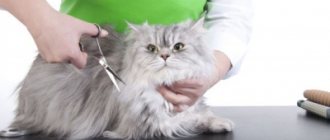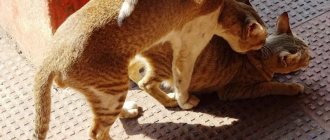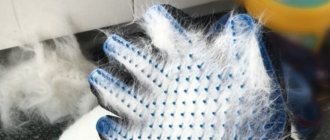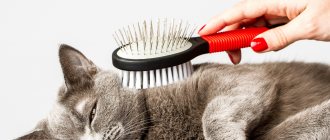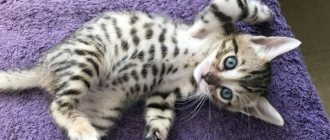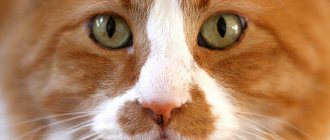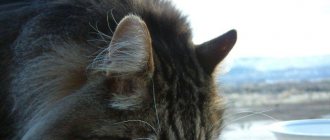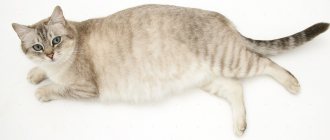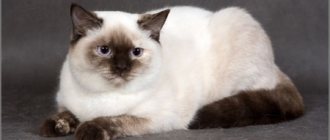Furry pet lovers often wonder: is it possible to groom cats? The answer is clear - yes, it is possible, sometimes even necessary! Grooming cats and cats is becoming increasingly popular. The reasons are dictated by the need to provide complete care for your pet’s fur coat. And if you get creative, the animal takes on an interesting image.
Necessity
The owner decides whether the pet needs a haircut.
With regular coat care and timely combing of tangles, animals can do without a haircut. Caring for the hair of a long-haired cat takes a lot of time. In the absence of regular combing, tangles form very quickly. Cats of the Persian breed with a soft hair structure and a coat length of up to 10 cm are especially affected. These animals require daily combing. Individuals who have not been accustomed to daily care since childhood often actively resist.
Trying to deal with the tangles on its own, the cat swallows a large number of hairs. The same thing happens during licking during molting. Hair balls in the stomach mix with food, bezoars are formed, which move through the intestines and increase in size. The condition can cause vomiting, constipation, intestinal bleeding and obstruction.
Tangles located next to the skin are especially dangerous. They cause inflammation of the epidermis, and flies can lay eggs under them. Persian cats in neglected condition definitely need a haircut.
Cats of the Maine Coon, Norwegian Forest cat, and Siberian breeds have shorter hair that is not prone to tangles. Their fur has a two-layer structure that creates an air gap between the skin and the environment. In shorn individuals, thermoregulation is disrupted. Veterinarians have different opinions on whether cats of these breeds should be shaved regularly.
Color-point cats (Neva Masquerade) or tipping (British breed) need to be shaved with caution; the color of the fur on the belly may become darker. Cats of short-haired breeds are cut in exceptional cases: for medical reasons, in case of indelible dirt
Cats of short-haired breeds are cut in exceptional cases: for medical reasons, in case of indelible dirt.
Is it true that cats can be cut?
For cats that live in the private sector and spend a lot of time outdoors, careful care is essential. After a walk, your pet may return not only with dirty hair, but also with hair matted into lumps. In this case, scissors will come to your aid. And if your pet has long, thick hair, then to avoid such troubles it makes sense to get a beautiful haircut with the onset of the warm season. If your cat is domestic, and you have enough time, effort and patience to take care of your pet’s fur every day and keep it clean and tidy, you can avoid going to the “cat” hairdresser - groomer. Even if there is no need to cut your pet’s hair, it is advisable to use a fuminator or slicker; they comb out the dead undercoat without touching the living one.
Benefits and harms
Like any grooming procedure, cat trimming has its positive and negative properties. Let's look at them in detail.
Relief from heat and health problems. There is a very common stereotype that representatives of long-haired breeds suffer from heat, especially during the hot season.- It is necessary to cut a cat if for some reason (for example, due to age) it cannot care for its fur, and you do not have the opportunity to constantly care for it. All this can soon lead to a visit to the veterinarian, and in worst cases, to surgery.
- Caring for a cat can also save the lives of owners who suffer from allergies or asthma. It will help eliminate the factor leading to suffocation and exacerbation of the disease.
- Many cats have a negative attitude towards haircuts. It, like bathing, causes discomfort and stress for the cat. After this, the pet may be depressed, and due to resentment, it may even become offended and ignore the owner. Particularly proud pets can leave a “surprise” in their owner’s slippers in retaliation for an attack on their fur coat.
- After cutting, the cats' hairs become a little smaller. Even the color of the animal may become lighter. If the coat is shortened too much, the animal will feel unwell and may experience dryness and loss of elasticity.
- There are cases when in some areas of the skin the hair does not grow back after cutting. This means that alopecia appears. This is caused by hypothermia and improper hair growth. This condition is mainly characteristic of dogs, but there have been cases when it also occurred in cats. If baldness began to appear even before the cut, do not try to solve the problem: here you need to contact a veterinarian.
Why you can't cut cats
Now let's look at the reasons why it is undesirable to cut cats:
It is not recommended to cut your hair bald during the off-season when there is no heating at home. This usually causes discomfort and hypothermia in the animal. You should not cut short-haired cats or cats. Wool protects the skin from dryness. Cases have been recorded when it stops growing in some places after grooming. If there is an air conditioner or fan in the house, the cat may catch a cold or get a skin burn in the sun. If your pet has smooth, well-groomed fur, there is no need for a haircut. After it, the structure of the hair changes, it becomes much thinner. You cannot cut cats of semi-longhaired breeds. Their fur performs the function of maintaining thermal balance, saving them from overheating and cooling. These include Norwegian Forest, Siberian, and Maine Coons. With careful care of the coat, systematic combing and bathing in a special shampoo and conditioner, it will be possible to keep it in excellent shape.
It is important to use special feed. In some breeds, frequent haircuts cause color changes.
You should also not trim the hair on the animal’s head or the tip of its tail. If the tail is completely bare, the cat will chew it and may injure it with its teeth.
To cut or not to cut? All about cat trimming
Hygienic, high-quality care for pets is called grooming.
The complex of care measures includes combing out excess undercoat, haircut (sometimes shaving), bathing, cleaning the ears and plaque from the teeth, trimming and sealing the tips of the claws. Compared to dogs, cats require less maintenance to keep them hygienically clean. Many veterinarians believe that cats do not need partial or complete hair trimming, since such a procedure can cause more harm than good. And they recommend cutting your pet’s hair only when necessary.
Haircut procedure
First of all, the cat must be secured on its side, holding the front and hind legs. If your pet is aggressive and bites, it is better to put a plastic collar on it during the procedure. You can also attach a binder (paper clip) to the back of your neck. At the same time, the cat falls into childhood, it seems to him that his mother is holding him in her teeth, and he behaves much calmer. Sometimes for overly excited cats, inhibitors, sedatives, sleeping pills or anesthesia are used during grooming. Such methods can be used only in extreme cases and always after passing the necessary examinations. But these are very unsafe methods! Never use them at home yourself. They can cause significant harm to your furry friend.
If there are tangles, you first need to trim them with scissors.
This must be done very carefully and slowly so as not to damage the animal’s skin. And then cut the back and sides with a clipper
You need to turn on the machine away from the cat so that its noise does not frighten the animal too much. Let the cat get used to the sound, only then can you start cutting. The skin should be slightly stretched so as not to injure it. Also, don’t forget about the attachment for the machine. It is better to choose at least 3 mm. If you use the machine without an attachment, you can injure your skin.
The fur from the belly should be trimmed slowly so as not to injure the nipples and intimate area. It is best to prepare these areas before machine cutting. Trim the hair around the nipples and intimate area so that these areas are clearly visible. Cats' tails can be trimmed at will. You can give it any shape that your imagination suggests, but you must leave at least a small brush at the tip of the tail. Otherwise, the cat will not recognize its tail and may bite it, causing pain to itself.
The cat is very aggressive
Grooming your pet can take a lot of your time, don't expect to get it done in half an hour.
If your cat is aggressive, bites and breaks out, it is better to trim its fur. The fur will remain longer, but this way you will avoid unnecessary aggression of the animal. Since cutting against the grain irritates the pet even more.
Several approaches are possible
Don't try to cut your pet's hair in one go. Take breaks and pet your pet to calm him down and help him endure an unpleasant procedure more easily. After a haircut, you also need to be gentle and friendly with the animal. You should not laugh loudly at your haircut during or after the procedure. Your animal may have a hard time accepting such an outburst of emotion from its owner.
How to trim or shave your pet if necessary?
Hairdressing procedures at home are carried out according to a certain algorithm:
- Trimming nails. It is carried out with special tweezers, pre-disinfected. Light pressure on the paw pads causes the hidden claws to extend; the owner only needs to trim the very tips. This procedure will prevent scratches during cutting.
- When performing the initial manipulation, an assistant is needed - he must hold the animal, preventing it from running away. Some cats become aggressive when they see grooming tools. For safety, the pet is wearing a plastic collar that prevents it from biting.
- The cat is laid on its side, its paws are securely fixed. For cutting, use a clipper or scissors. The first will avoid damage to the skin, but can irritate and frighten the pet with its buzzing.
- The fur is removed from the sides, then moved to the back and belly. Hair removal is carried out both in the direction of its growth and in the opposite direction. The remaining long hairs are trimmed with nail scissors. There must be a tassel on the tail.
After the procedure is completed, the pet is bathed with a special cat shampoo and dried with a towel. If the animal is not afraid of a hair dryer, then it is also used for drying. Veterinarians recommend using the services of specialists. The groomer will carry out the manipulation quickly, without injuring the cat’s delicate skin or damaging the whiskers.
How often can you shave or cut your pet's hair? The fur grows back within 3-6 months. If spots form, the animal grows unevenly, then it needs to be shown to a veterinarian.
What tool is needed for cutting
Grooming cats is done with two tools - a clipper and scissors. A nice and neat haircut can be achieved by alternating both tools in different areas. It is convenient to use scissors to trim what is left after the device. Cutting long hair with scissors is time-consuming and traumatic, and the result is not always neat.
Select scissors of medium size with sharp edges and rounded ends. The machine does not injure the cat, it is comfortable to work with and will require less time. My only wish is to choose a model with minimal noise so as not to frighten your pet. When working with a human machine, it is difficult to achieve straight lines. It is better to purchase a special device. For long and thick wool, its power should be at least 45 W.
Additionally, for a haircut you will need:
- Fine-tooth comb
- Hydrogen peroxide for skin cuts
- A place for cutting, such as a small table
- An old towel as a bedding to collect the wool in and throw away
- Cat entertainment toy
Siberian
The Siberian cat is one of the oldest breeds; it has been known since the 16th century. Initially in Russia, such cats were called Bukhara, which indicates that perhaps the homeland of their ancestors was in Central Asia. Regardless of where the ancestors of the Siberian cat came from, it is absolutely clear that this breed lived for a long time in the Siberian climate; these cats are perfectly adapted to endure severe, prolonged frosts and heavy snowfalls. Nowadays, the popularity of the Siberian cat as a pet is increasing every year.
Adviсe
Before deciding to groom your cat, you need to take into account the recommendations of experienced professionals. Thus, professional groomers advise, if possible, not to touch the tail, which is the most vulnerable part of the animal’s body.
Even minor damage to it causes enormous suffering to the pet and can negatively affect the cat’s overall well-being. You should also pay attention to the stomach, especially the lower, most tender part.
The next point that experts advise you to pay attention to is the psychological preparation of your pet. This procedure may require some time and patience from the cat owner.
So, long before the planned haircut, you need to start accustoming the animal to the table. This should be done very carefully and consistently.
To begin with, simply place the cat on the work surface, stroke its sides and back and, if possible, try to lay the pet on its side without stopping stroking. After the animal stops behaving warily on the table and responds happily to caresses, they carefully begin combing, each time increasing the time of the procedure.
If you are consistent and do not forget to regularly brush your cat on the table, then over time she will get used to the procedures and will perceive both the table and the comb quite calmly. The next important step will be to accustom your pet to the sound of a running machine. Ideally, it is better to purchase a silent device, but if this is not possible, then you can try to accustom the cat to the noise of a running electric motor. To do this, a few days before the haircut, you should turn on the clipper for a short time, while holding the pet in your arms and stroking it.
In general, grooming a cat should be perceived as an extremely last resort when the animal’s fur is hopelessly neglected and it is not possible to comb out the tangles. As for haircuts for decorative purposes, in this case it is necessary to be guided by the cat’s reaction to the procedure, while assessing the possible consequences. When performing complex show hairstyles, it is recommended to give the cat a rest and trim it in 2-3 stages.
It should also be remembered that a trimmed mustache, as well as hair inside the ears and on the head, significantly reduces the sensitivity of the smell receptors. There is no need to groom overly aggressive or overly active pets yourself. It is better to take such animals to an experienced groomer, where sedatives may be required. Thus, each owner must decide for himself whether to cut his pet’s hair or not. To do this, you need to soberly assess the benefit/harm ratio and focus primarily on the well-being and mental balance of your pet.
To learn why cats need to be groomed, watch the following video.
Cat grooming at home by professionals
If you are hesitant to start grooming yourself, you can call in professionals. What is attractive about grooming at home with the help of specialists?
- your pet does not experience the stress associated with being in an unfamiliar environment;
- a professional will cope with the task faster and better;
- there is no need to purchase the necessary tools:
- you get rid of unnecessary hassle and save time.
- It is possible to trim several animals quickly and at a reasonable price.
- Haircut "Dragon". This haircut is different in that a mohawk remains on the cat’s back, and the rest of the hair except the head is completely removed.
- Puma haircut. In this case, only the hair from the back surface of the body is removed. The head, paws and tail are not cut.
- Haircut "Lion". After shearing, the animal really looks like a lion, as it is left with only the “mane” and fur at the tip of its tail.
See also: Red cats: amazing creatures with the energy of the sun
Haircut "Lion"
Grooming
To ensure that the cat's fur does not cause various inconveniences to it and those around it and to look good, the owner must regularly carry out a number of hygiene procedures. If it is enough for owners of short-haired cats to brush their pet several times a week with a massage brush, then owners of long-haired cats need to do this daily with several types of brushes. Bathing for a pet with long hair and developed undercoat also needs to be organized more often than for a short-haired one.
In addition, you need monthly washing of the coat using dry shampoo or a special spray, regular application of conditioners with an antistatic effect, lotions and balms for the health of the coat. Otherwise, tangles will form that need to be cut out, and all sorts of skin diseases will form.
Why does a cat need a haircut?
Many observers believe that a haircut is just another quirk of the owner, a desire to stand out and attract attention. But such a procedure is simply necessary to maintain animal hygiene.
This is especially true for breeds with long hair. Experienced breeders provide several compelling reasons for professional grooming of animals.
Cleanliness in the apartment
Fluffies' hair falls out even between seasonal molts. Wool in the apartment where a cat lives is becoming a common occurrence. Upholstered furniture, bedspreads, carpet - perfectly catch hairs, causing a lot of trouble for the owners. High-quality grooming or haircut is one way to get rid of this phenomenon.
Healthy cat skin care
If the owner of a Persian or Siberian is a busy business person, then he does not always have enough time to comb and care for the pet’s fur. After all, these procedures cannot be rushed and require thoroughness and accuracy. And if the pet is also quite capricious, then every combing can turn into a local mini-battle. Falling hairs that are not removed in time become entangled in living hairs and gradually become tangled.
Grooming cats yourself at home allows you to remove single clumps. But at the same time, an unsightly bare clearing will remain in the cat’s luxurious hair.
In large quantities, tangles cause local overheating and become the cause of dermatitis, eczema, and skin diseases. What can we say about the pain experienced by the cat? A professional groomer can remove tangles and maintain the aesthetic appearance of the fluffy coat.
Prevention of intestinal disorders
This is the third compelling argument, scientifically based. When licking, the animal swallows the fallen hairs. If there are too many of them, then in the stomach they turn into large dense lumps.
Sometimes a cat is able to regurgitate matted fur, but it happens that these lumps seriously disrupt digestion and even cause intestinal obstruction.
The beautiful and aesthetic appearance of the cat will delight not only the owner, but also his guests. Animals with any length of hair can be cut 2-4 times a year.
Fur length
The following types of breeds are distinguished depending on the length of the hair:
- Naked. This variety was not specially bred, and the main reason for the lack of hair is a gene mutation. If both parents are bald, the kittens that are born will also have no hair. However, there is still a small amount of fine hairs on the skin that are not able to protect the animal from the cold.
- Short-haired. This species has fur that does not exceed 5 cm in size. Despite the fact that the hair is thick, it does not require special care. It is enough to scratch the animal 1-2 times a week with a special brush to get rid of lost hairs.
- Semi-longhaired. The variety has long hair, but the undercoat is not very thick and fluffy. The difference in fur length is most noticeable in winter and summer.
- Long-haired. This beautiful fluffy breed's fur grows no less than 10-12 cm. The animal requires special, careful care so that the fur coat shines, does not become disheveled and does not become covered with tangles. In addition, animals are prone to heavy shedding, which increases the risk of hair accumulation in the digestive organs.
Return to contents
Varieties
Cat haircuts are divided into two groups: model and hygienic. The latter pursue very specific goals and are carried out in order to protect the animal from overheating and tangles, as well as for veterinary indications. These include diseases of the skin and gastrointestinal tract, increased secretory activity of the sebaceous and para-anal glands, as well as the senility of the pet, when it is no longer able to cope with its fur on its own.
Model haircuts are performed exclusively for decorative purposes to make the animal more attractive, as well as before cat shows. The most common of them are haircuts like a lion, like a dragon, and like a dinosaur. The puma hairstyle is also very popular and is a simplified version of the lion haircut. The only difference is the design of the tail: for example, if in a “puma” it is cut almost bald, then in a “lion” it repeats the shape of a real lion’s tail with a fluffy tassel.
However, the most creative can be called the “dragon” haircut, which includes various variations of cutting symbols, letters, ornaments and figures on the back of the animal. Despite the rather exotic appearance of the pet, most veterinarians warn owners against performing this haircut. This is due to the fact that after cutting the patterns, the fur on the pet’s skin becomes uneven, which greatly disrupts thermoregulation and does not allow the body to adapt to this type of heat transfer.
A graduated hairstyle has a much stronger negative impact on the cat’s condition than uniform haircuts, to which the body adapts over time. The same, but to a slightly lesser extent, applies to the “socks”, “sock socks” and “puss in boots” haircuts, which are also very popular among cat owners. Among exhibition haircuts, “harlequin”, “modern” and “continental chic” are very popular.
Why do you need to groom your pets?
There are many situations in which grooming cats is acceptable, if not vital. And we’re not just talking about going to a felinological competition. Very often, veterinarians advise resorting to grooming when they notice a problem with the animal’s fur or skin.
In this regard, all types of haircuts for cats can be divided into two:
- Model.
- Hygienic.
Model grooming is performed mainly for exhibitions and is a real work of art.
A completely different matter is cutting the fur, which is necessary to maintain the health of the pet. Hygienic cat grooming has a more familiar look and is easy to perform:
- Most often, it is done to avoid matting of long hair or to remove formed tangles that cause pain to the cat.
- Cats actively lick themselves and can either injure themselves trying to gnaw out the mat, or eat a lot of hair, which rolls into lumps in the stomach and can cause intestinal obstruction.
- The veterinarian may prescribe a haircut in case of skin diseases or parasites.
- Some animals have a problem such as feces sticking to the long hair near the hind legs and tail. In this case, you don’t have to cut the whole animal, but just shorten the “pants” a little.
- Many cats with long or semi-long hair undergo grooming in the summer heat to protect them from overheating. This is especially necessary for Siberian cats, Persian cats, Norwegian forest cats and others accustomed to colder climates.
- It also happens that an old or sick animal cannot care for its fur on its own. In this case, a haircut helps him stay clean and look decent.
Model haircut "Dragon"
Types of exhibition haircuts
Model cat grooming can be done not only for a trip to an exhibition. Many owners regularly visit the salon to give their pet an original look. Each hairstyle is individual. And yet, there are several of the most popular varieties, on the basis of which groomers create their exclusive works of hairdressing art.
- "French Lion" For this hairstyle, the back, top of the paws and base of the tail are completely trimmed. The head and neck fur remain intact, giving the impression of a luxurious mane. The tip of the tail is not cut either. A specialist can give it the shape of a lion tassel, a pompom, a stepped herringbone or a neat whisk. Sometimes the fur is shortened just a little, resulting in a fluffy squirrel tail. The length of the “socks” and “gloves” on the paws can also vary. Thus, a unique image of the animal is created.
- "Puma." This haircut is done in almost the same way as the “Lion” option, but in addition the fluffy shirtfront on the chest is preserved.
- For the “Dragon” model, the sides and belly are cut smooth, while the hair along the ridge and tail remains untouched. It is only given the shape of a carved comb with sharp teeth.
- “Puss in Boots” fully corresponds to its name: the fur on the animal’s back is shortened, and the upper part of its paws is cut off to make neat boots.
There are also more intricate haircuts - such as “Modern”, “Continental”, “Harlequin”. All of them are performed only by specialists.
Model haircut "Puss in Boots"
Types of cat haircuts
A hygienic haircut is done no more than 2 times a year, so as not to harm the structure of the coat and skin. If a cat will participate in an exhibition, the last trimming is done no later than six months before the event. The haircut is usually done with a clipper, leaving a hair length of about 3 mm. After this procedure, the animal’s skin becomes “plush” to the touch. It is not recommended to trim your cat on your own; it is better to contact a specialist, a pet beauty salon: for high-quality trimming you need special tools - various types of hairdressing and thinning scissors, a clipper, a set of combs.
You can't cut cats completely bald! This will disrupt the heat exchange process and may cause skin irritation. When trimming a cat, at least a small part of the fur must remain to protect it from sunlight and cold.
Sometimes cats are given model grooming for aesthetic reasons. There are several options for a model cat haircut, here are the most popular:
- "Puma" - a short-cropped body and a head in the form of a lion's mane.
- “Dragon” is a curly haircut in which various figures and symbols are cut on the body.
- “Golfies” - hair is removed only on the upper part of the paws.
When performing grooming of any form, there are certain rules:
- In order not to damage the whiskers and hair in the ears, the hair on the head, muzzle and in the auricle is not cut.
- “socks” are left on the bottom of the paws;
- do not touch the hair on the front legs below the elbow and on the hind legs under the jumping joint;
- leave hair at the end of the tail (a section of at least 3 cm long should remain uncut).
When deciding whether to cut your cat's hair or not, you should not forget that the main goal is to ensure the pet's comfort. If you organize a nutritious diet, including vitamins and minerals, and properly care for the animal’s fur, there will most likely not be a need to cut it. The fur of a well-groomed cat always looks thick, shiny and clean.
Is it harmful to cut cats: video
- Is it possible to wash a cat with regular shampoo?
- Dry shampoo for cats
- Colt cutter for cats and cats: how to use
Do cats need to be trimmed and how often can this be done?
By providing proper care for pets, we can save them from the upcoming grooming procedure. If they still have a thick, shiny coat and their skin is healthy and elastic, then grooming will become unnecessary.
Kittens need to be accustomed to all manipulations from childhood. They should respond calmly to a comb and brush. It is recommended to brush daily. Besides being necessary, this is a useful and enjoyable massage.
But, if the fur often rolls into tangles, then experts advise cutting it as rarely as possible. Whether cats are clipped with clippers or scissors does not matter. Only a machine haircut will look more impressive and aesthetically pleasing.
As a last resort, you can cut your cat's hair for the summer, but in winter you should refrain. The frequency of haircuts is from one to three times a year.
From all of the above, we can conclude that grooming cats is not necessary. If there is no reason, it becomes a tribute to fashion. Don't forget about the consequences of meaningless haircuts and the stress our pets experience. Often cats become sad after they have been clipped, shiver from the cold and treat their feeder without the former enthusiasm and trust.
Why cut your cat's hair?
Cats have a natural need to constantly care for their fur coat. But very often this is not enough, especially for fluffies with a fur length of more than 3 cm. Special care is recommended for such pets, including regular combing, removing tangles and trimming excess hair.
Cat trimming procedure
- It is necessary to fix the pet in a position lying on its side, holding it by the hind and front legs.
- First of all, the tangles are cut off with scissors. After this, they continue cutting the hair on the sides of the body and back using a clipper.
- When trimming fur from the belly, you should carefully avoid the nipples and intimate areas. Experts recommend first cutting the hair in intimate areas with scissors and then completing the manipulation with a clipper. It must be remembered that cats' skin is very thin and easily injured. Therefore, while working with the machine, you need to tighten it so that skin folds do not get under the blades.
- At the end of the procedure, the cover on the paws is cut off.
- The hair on the animal's head is not trimmed; it is possible to shape it with thinning scissors. It is strictly forbidden to trim the mustache, as it is an important organ of touch.
- Tail trimming is carried out at the request of the owner.
If you can’t cut your cat’s hair in one procedure, you can divide it into several stages. This will allow the pet to avoid unnecessary stress, and the master from bites and scratches.
After grooming, the animal must be bathed and dried with a hairdryer. If your cat is afraid, you can remove cut and stuck hairs by wiping it with a damp cloth or chamois cloth. During the cold season, you should create a comfortable microclimate without drafts in the room where the pet is.
Recommendations for haircut and care
— The growing fur of a cat changes structure and color after cutting. — It’s not worth trimming the belly and back of cats with color point and tipping - the growing fur is several tones darker. — It is possible that the growing fur may not reach its original length. — It is strictly forbidden to trim the hair in the ears. Also, do not touch the hair on your head or whiskers with scissors! — It is recommended to trim especially active pets using sedatives. Do not do this yourself, contact a specialized salon.
Short-haired pets can be brushed once a week and bathed as you wish. Long-haired cats need to be washed at least once every 2 months and their coat thoroughly brushed daily. Experts recommend cutting the hair of cats with a length of more than 3 cm. It is better to consult with specialists about the possibility or necessity of cutting short-haired cats.
Grooming cats is a useful procedure that helps us and our pets. Cut your hair yourself or get help from a professional – it’s up to you. The most important thing is that your decision is thoughtful and brings benefit and comfort to our pets.
The question of whether cats can be cut is asked by many pet lovers. Experts answer it positively - yes, it is possible, and sometimes even necessary! The reasons may be different: heat, sticky hairballs, inability to provide adequate care for your pet’s fluffy coat.
In what cases can you not do without a haircut?
Most owners have their own opinion about the indications for grooming a cat:
- getting rid of fur on furniture and carpets during seasonal shedding;
- allergies in the owner and family members (a shorn animal has less fluff, which causes an allergic reaction);
- prevention of overheating (in the summer, cats are hot due to their thick fur coat);
- solving problems with hair (it is easier to remove fleas, ticks, burrs).
Owning a representative of a long-haired breed while suffering from allergies, helping a pet in the heat, solving the problem of seasonal shedding - experts treat such wishes with irony. These are the whims of the owners, and not a real need. Professionals allow haircuts only in two cases:
- To get rid of large tangles. Matted fur causes pain and itching, and involuntary scratching of problem areas. When there is a massive accumulation of them, the cat is cut to relieve discomfort and prevent the development of dermatological diseases.
- As part of preoperative preparation. Before surgical interventions, the animal is not only cut short, but also shaved.
A cat’s beautiful hairstyle pleases its owners, not the cat itself. An incorrectly trimmed tail can even cause your pet to try to chew it off.
Breed Features
The harsh climatic conditions of Siberia contributed to the formation of strong, developed muscles, a large body and thick, dense wool in animals. The weight of an adult Siberian cat exceeds 10 kg. The paws are not too long, powerful, round in shape with tufts of hair between the toes. The tail is bushy, wide at the base and gradually tapering towards the end. The chin is massive, and the ears are small, with a slight tilt forward. The eyes are large and widely set. Siberian cats have a wide variety of different color options.
Siberians have an independent, strong-willed character. They will always find something to occupy themselves with and will not pester their owner unnecessarily. In addition, they are good hunters and enjoy catching mice or birds. Siberian cats do not like to sit on their hands for a long time, and of all family members they become attached only to one person.
The Siberian cat is a long-haired breed. Its coat is very thick, with a dense undercoat. The guard hair is long and hard. There is a fur collar on the neck, and “pants” on the hind legs. This gives the Siberian breed a resemblance to the Persian.
Source
How to reduce unpleasant consequences to a minimum?
To alleviate the stressful state, you need to try to gradually reconcile the animal with the procedures performed. The main method is psychological:
rid the cat of contact with unpleasant objects - nail clippers, scissors, hair clippers; distract with treats, new toys, favorite activities; during and after the manipulations, constantly talk and stroke; Do not laugh or focus on the appearance of the trimmed cat.
If there are no results from psychological assistance, you should visit a veterinarian and get the necessary medications. The list of possible medications is presented:
- Pheromones - aerosols of synthetic origin. After spraying the substance, animals experience an emotional uplift and a feeling of security and safety.
- Antidepressants - prescribed by a veterinarian when a pet falls into a state of deep depression. Therapy is carried out with Valium, Diazepam.
In addition to medications, the doctor may recommend wearing a special collar soaked in pheromones and a complex of essential oils. It allows the animal to quickly get out of a stressful state and stop constantly licking itself.
Cats do not always react aggressively to hairdresser's manipulations. Indifference to procedures is observed in sterilized animals. Their psyche is more resistant to external stimuli, their behavior is characterized by calmness and pronounced laziness.
Experts point out that changing the appearance of furry pets cannot occur only at the whim of the owner; the procedure requires good reasons. The desire to create a fashionable “hairstyle” can cause a long-term quarrel between the animal and the owner, cause hidden anger in the pet and provoke a long cold war
Where can I groom my cat?
You can trust the specialists by visiting a special salon. Or you can do everything yourself at home. We'll talk about this in more detail below.
In the cabin
Today, many animal hairdressing salons operate successfully. They offer a wide range of services and types of pet grooming.
The main advantage is that the grooming of dogs and cats in the salon is carried out by professionals and modern specialized equipment.
Also, the salon will do grooming of any complexity, which cannot be said about an independent approach.
On your own at home
To cut a cat's hair at home, first of all, you need to acquire the necessary tools and all the necessary equipment.
Needed:
- Cutting and thinning hairdressing scissors with blunt ends;
- Machine with nozzle No. 3;
- Flat comb and brush for combing out the undercoat;
- Table for the procedure. The surface is covered with a thick blanket and then a sheet.
- Means for bathing an animal after a haircut.
But it’s not enough to just provide yourself with all the above equipment. To carry out the procedure successfully and safely, minimal grooming skills are required. Otherwise, it is recommended to entrust the matter to specialists by visiting a pet salon in your city.
Salon or home haircut?
The question of whether to contact a specialized office or trim the pet’s fur themselves arises among owners very often. There are quite a lot of arguments in favor of both options. Grooming cats at home is much cheaper, and many mustachioed purrs perceive trips to the salon as very stressful.
The difficulty is that not all animals tolerate grooming calmly. Some people so actively resist attempts to cut their hair that they have to be sedated. Most often, mild muscle relaxants are used in this capacity: these medications do not completely immobilize the cat, but reduce activity and make all its reactions more inhibited. Only a professional can choose the right medicine, give the correct injection and monitor the condition of the four-legged patient.
Even choosing a shampoo for bathing before a haircut sometimes turns into a difficult task. An incorrectly selected grooming product can damage the coat, cause allergies or skin irritation, and in the worst case scenario, even cause the animal to go bald.
Additionally, cat grooming varies greatly in difficulty. Hygienic or the simplest of model haircuts, such as “lion”, “puma” or “puss in boots”, can be easily done at home. Others, more complex ones, can only be done by a specialist. Thus, it is often much easier to pay for a trip to a clinic or salon. Usually a groomer gives a cat a haircut in an equipped office, however, a home call is quite possible.
Animal clipper
Grooming a cat at home: what will you need?
If you still decide not to go to the salon, then keep in mind: grooming cats is not the easiest task. You will need a lot of patience and some tools:
- Hair clipper.
- The attachments for it are at least 3 mm long (it is best to use veterinary attachments No. 3 for these purposes).
- Comb-comb.
- Regular or hairdressing scissors (if you want a “designer” hairstyle, you can take both regular and filer scissors).
- A high table or ironing board at which you can work comfortably.
- Just in case, prepare hydrogen peroxide and cotton wool.
And, of course, you need to take into account that for such a procedure you will need an assistant, or better yet two. After all, most animals perceive attempts to cut their hair very aggressively, and someone will have to hold the wayward cat so that she does not injure her “hairdresser.”
Place your pet on the tabletop, holding him by the front and back legs so that he cannot twitch. Carefully trim the fur first on the back, then on the belly, paws and tail. If necessary, trim any stray hairs.
After completing the procedure, be sure to bathe the animal to wash off any remaining hair on its skin.
Professional groomer kit
